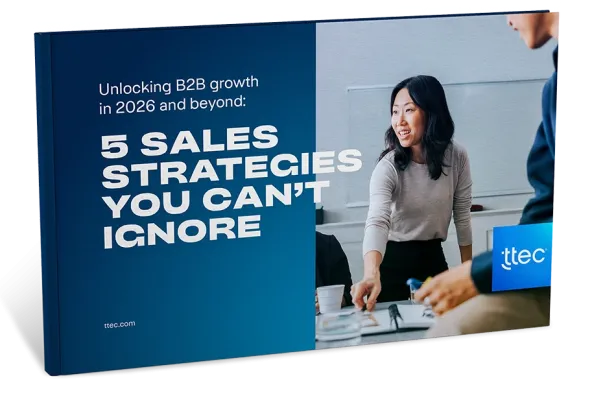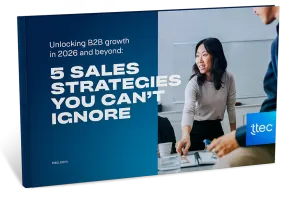It’s always been challenging for brands to stand out among competitors, but as the world emerges from the pandemic it’s harder than ever for sellers to engage meaningfully with customers.
Differentiating yourself amid the flood of emails, LinkedIn messages, and phone calls we all get can be difficult. The brands that thrive in the new normal will be those that reach the right customers at the right time with the right approach.
“The pandemic has made it that much harder to really engage with prospects and really kind of break through the noise that we all receive,” said Holden Olsen, TTEC’s vice president of global sales operations.
Sales incubator programs can help. These adaptable and quick-to-launch solutions can focus on any stage of the sales funnel, or multiple stages. Using data and analytics, they generate insights that can inform decisions around lead prioritization and other factors that drive ROI.
Olsen joined TTEC Vice President of Marketing and Sales Analytics Barbara Wingle and TTEC Director of Sales Operations Eric Bisbing in a recent webinar to discuss how to turn sales pipelines into powerful lead generators. Here are some of their top tips:
Use analytics to prioritize leads
When it comes to driving sales, high-quality leads are critical. It may be tempting to cast a wide net but doing so can result in too many leads. This typically causes business development teams to struggle to keep up, wasting too much time and manpower on leads that aren’t going to convert.
Instead, lean on data analytics to prioritize leads that have a high likelihood of purchasing.
When a sustainability company came to TTEC for help generating better leads, it had a pool of 10,000 businesses it wanted to engage – but no strategy for prioritizing them. Sales representatives didn’t know where to begin.
TTEC’s advanced analytics solutions helped the company model and score leads, determining which ones were the most likely to convert. Data showed that only a small subset of those 10,000 businesses (about 38%) actually matched the profile of customers the business wanted to target, said Bisbing. This made prioritizing the leads much easier and spurred a 130% increase in monthly sales meetings generated, said Olsen.
“It allowed them [company leaders] to see that efforts in prioritization were really paying off and led to some really qualified meetings that the sales team was really happy and engaged to pursue,” Olsen said.
Build meaningful connections
Of course, it’s easier to get meetings with leads if sellers are already on their radars. That’s why networks are so important. Most sales are still closed over the phone, but sellers need to cultivate a relationship with prospective buyers across various channels first.
LinkedIn can be a powerful way to connect with prospects, Bisbing said, but only when it’s used effectively. Too often, sellers send prospective customers a LinkedIn invitation to connect and then immediately follow it up with a sales pitch.
Requesting a meeting should never be a seller’s first interaction with a lead. Instead, it’s important to form a relationship first, one that builds trust and demonstrates the seller’s value. Do this by creating or sharing engaging digital content.
Take notice of who’s in your network – their job titles and industry – and post content and thought leadership that’s relevant to them. This will lead to a more robust network, one that’s primed to hear your sales pitch when the right time comes.
The old days of merely picking up the phone to make a sale are over. Businesses that want to truly stand out need to have a multichannel approach.
Align sales and marketing
Traditionally, sales and marketing teams have operated largely in silos. The marketing team was tasked with generating leads to fill the top of the funnel; the sales team’s job was to close sales at the bottom of the funnel.
But to thrive in the new normal, businesses need to align their sales and marketing into one team, unified by shared goals, said Wingle.
“What it boils down to is ensuring everyone has a common vision,” she said.
Working together is a win-win. The marketing team can generate higher-quality leads since it has a better idea of what the sales team needs, and the sales team is more likely to close deals because it’s working off of better leads, she said.
Aligning the teams also drives bottom-line growth. When sales and marketing are aligned, conversion rates typically improve by nearly 40% and customer retention grows, said Wingle.
To learn more, and hear how TTEC helped a sustainability brand drive sales growth, watch the on-demand webinar, “How to transform your sales pipeline into a powerful lead generator with a sales incubator program.”















